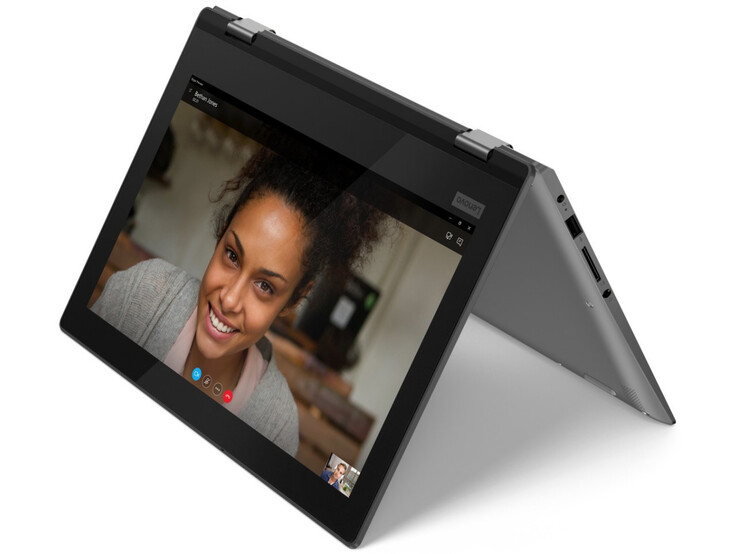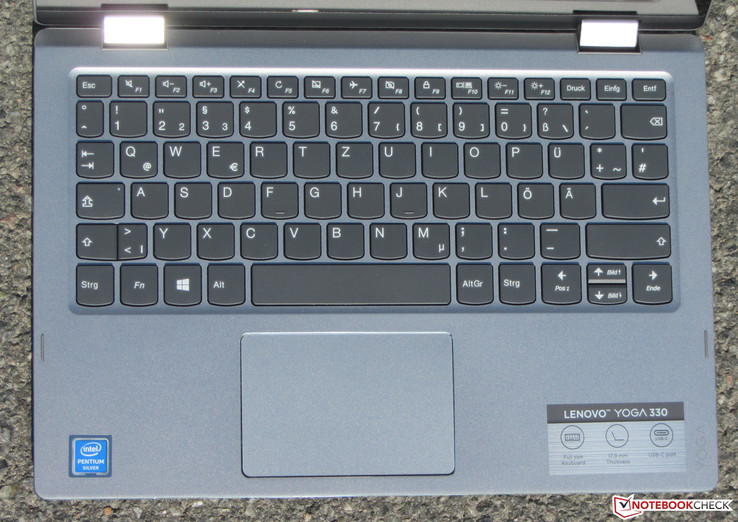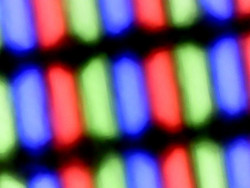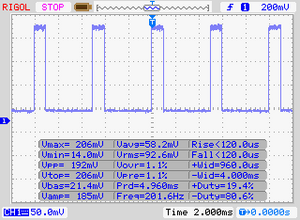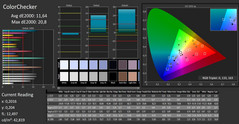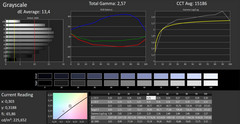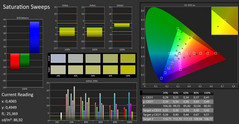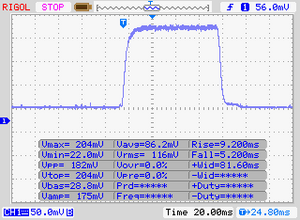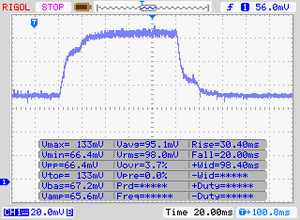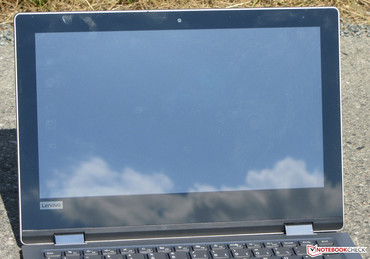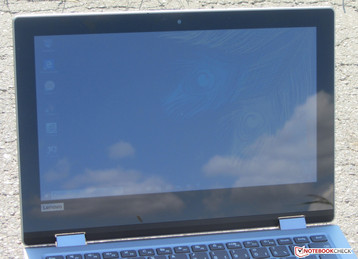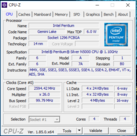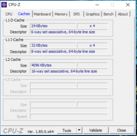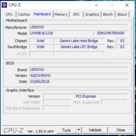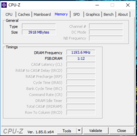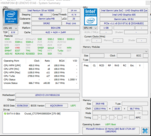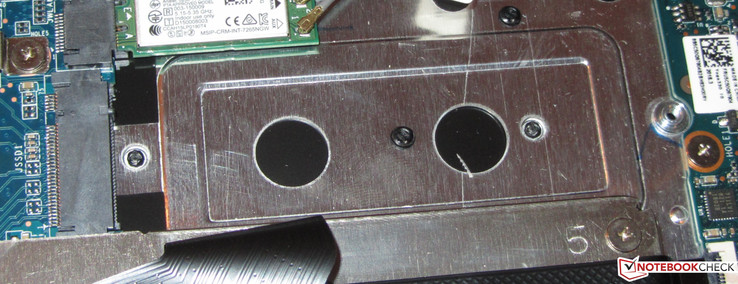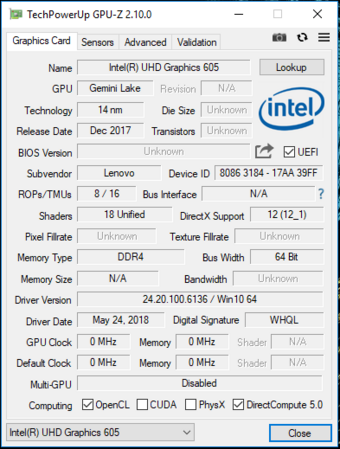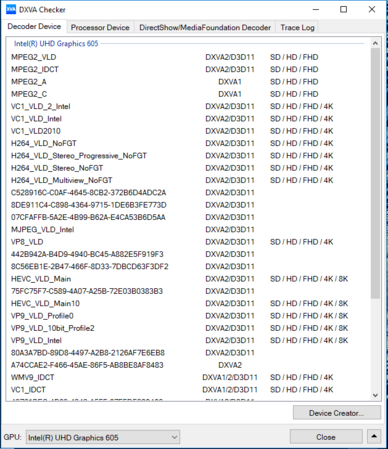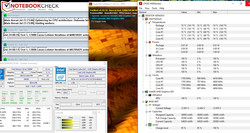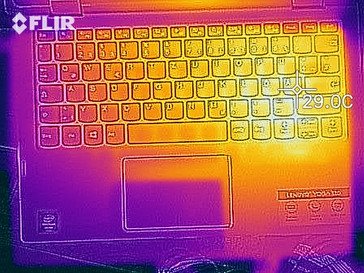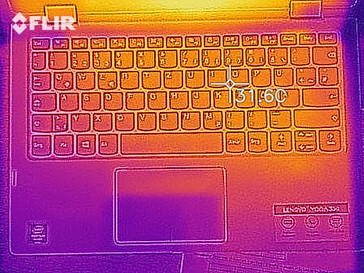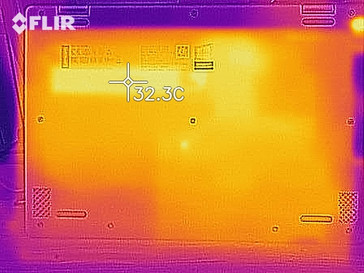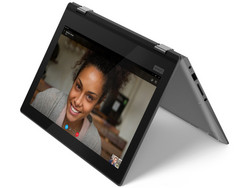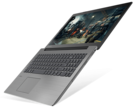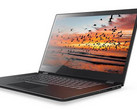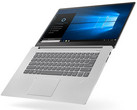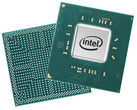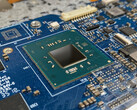Lenovo Yoga 330-11IGM (Pentium N5000) Laptop Review

The Lenovo Yoga 330-11IGM is an 11.6-inch convertible laptop. The device runs on a Pentium Silver quad-core processor from the Gemini Lake generation. The convertible's competitors include devices such as the Acer Spin 1 SP111-31, the Medion Akoya E2228T and the Asus VivoBook Flip 12 TP203NAH.
Case & Connectivity - Lenovo Yoga convertible made of plastic and metal
The Yoga's case is constructed of both plastic (back of the lid, lower shell) and metal (top side of the base unit). Our test device is dressed in light gray ("mineral gray"). Alternatively, buyers can also select a black model ("onyx black"). In terms of manufacturing quality, the chassis does not appear to have any serious defects. The laptop's stability is also reasonably good. The battery is permanently installed, and the computer lacks a maintenance hatch.
In order to reach the inner workings, the bottom of the device must be removed: After all the screws on the bottom have been taken out, the lower shell can be released with the help of a putty knife or flat spatula. This must be executed carefully, as the shell is quite firmly affixed.
The little computer is equipped with the most important connections. There are two USB 3.1 Gen 1 ports (1x Type C, 1x Type A) and one USB 2.0 port (Type A). An HDMI connection is also available for video output. We are pleased with the way the connections are laid out. The aforementioned ports are located towards the back on both sides of the laptop.
The built-in memory card reader is not one of the fastest of its kind. While copying large blocks of data, the reader reached a maximum transfer rate of 67.5 MB/s. The card reader transferred 250 JPG image files (each around 5 MB) at a speed of 59.5 MB/s. We test memory card readers with a reference memory card (Toshiba Exceria Pro SDCX 64 GB UHS-II). Memory cards do not slide fully into the reader - they stick out a good 18 mm (~0.7 inches).
The Yoga 330's WLAN module has an Intel chip (Dual Band Wireless-AC 3165) that supports the WLAN standards 802.11a/b/g/n, as well as the fast ac standard. Our WLAN test, which is performed under optimal conditions (no other WLAN devices in the vicinity, short distance between the laptop and server PC), revealed data transfer rates in the below-average range.
Connections
| SD Card Reader | |
| average JPG Copy Test (av. of 3 runs) | |
| Average of class Convertible (28.1 - 209, n=23, last 2 years) | |
| Lenovo Yoga 330-11IGM (Toshiba Exceria Pro SDXC 64 GB UHS-II) | |
| Medion Akoya E2228T-MD61250 (Toshiba Exceria Pro M501 microSDXC 64GB) | |
| maximum AS SSD Seq Read Test (1GB) | |
| Average of class Convertible (28.9 - 253, n=22, last 2 years) | |
| Lenovo Yoga 330-11IGM (Toshiba Exceria Pro SDXC 64 GB UHS-II) | |
| Medion Akoya E2228T-MD61250 (Toshiba Exceria Pro M501 microSDXC 64GB) | |
| Networking | |
| iperf3 transmit AX12 | |
| Asus VivoBook Flip 12 TP203NAH-BP049T | |
| Lenovo Yoga 330-11IGM | |
| Medion Akoya E2228T-MD61250 | |
| Acer Spin 1 SP111-31-C79E | |
| iperf3 receive AX12 | |
| Asus VivoBook Flip 12 TP203NAH-BP049T | |
| Acer Spin 1 SP111-31-C79E | |
| Lenovo Yoga 330-11IGM | |
| Medion Akoya E2228T-MD61250 | |
Input Devices - Lenovo's 2-in-1 device does not have a backlit keyboard
Lenovo's convertible is equipped with a non-backlit chiclet keyboard. The flat, slightly roughened keys have a short travel and clear click-point. The keys offer a good level of resistance for our taste. The keyboard bends somewhat in the center during typing, but we did not experience this as particularly bothersome. All in all, Lenovo delivers a reasonably good keyboard that is well-suited for regular use.
The multitouch-capable ClickPad measures about 9 x 6 cm (~3.5 x 2.4 inches), providing plenty of space for the execution of touchpad gestures. Fingers glide easily over the pad's smooth surface. The pad reacts to input in all areas, including the corners. It has a short travel and a clear click point.
The touchscreen did not give us any trouble. It supports 10 touchpoints and reacts to input immediately.
Display - The Lenovo computer's display does not look correct from every angle
The Yoga's 11.6-inch touchscreen display has a native resolution of 1366x768 pixels. The brightness (212.6 cd/m²) and contrast (431:1) are too low. The competition has more to offer in both of these areas.
At brightness levels of 90 percent and below, the display uses PWM backlight flickering at a frequency of 200 Hz. A frequency in that low range could cause sensitive users eye problems and/or headaches.
| |||||||||||||||||||||||||
Brightness Distribution: 80 %
Center on Battery: 225 cd/m²
Contrast: 431:1 (Black: 0.52 cd/m²)
ΔE ColorChecker Calman: 11.64 | ∀{0.5-29.43 Ø4.78}
ΔE Greyscale Calman: 13.4 | ∀{0.09-98 Ø5}
61% sRGB (Argyll 1.6.3 3D)
38% AdobeRGB 1998 (Argyll 1.6.3 3D)
41.76% AdobeRGB 1998 (Argyll 3D)
60.8% sRGB (Argyll 3D)
40.42% Display P3 (Argyll 3D)
Gamma: 2.57
CCT: 15186 K
| Lenovo Yoga 330-11IGM TN LED, 1366x768, 11.6" | Acer Spin 1 SP111-31-C79E IPS, 1920x1080, 11.6" | Asus VivoBook Flip 12 TP203NAH-BP049T IPS, 1366x768, 11.6" | Medion Akoya E2228T-MD61250 IPS, 1920x1080, 11.6" | |
|---|---|---|---|---|
| Display | 22% | 9% | 36% | |
| Display P3 Coverage (%) | 40.42 | 49.67 23% | 44.23 9% | 59.3 47% |
| sRGB Coverage (%) | 60.8 | 72.6 19% | 66.3 9% | 77.3 27% |
| AdobeRGB 1998 Coverage (%) | 41.76 | 51.4 23% | 45.73 10% | 56.5 35% |
| Response Times | -22% | -29% | -9% | |
| Response Time Grey 50% / Grey 80% * (ms) | 50 ? | 36 ? 28% | 39 ? 22% | 30 ? 40% |
| Response Time Black / White * (ms) | 14 ? | 24 ? -71% | 25 ? -79% | 22 ? -57% |
| PWM Frequency (Hz) | 200 ? | 200 ? | ||
| Screen | 50% | 56% | 66% | |
| Brightness middle (cd/m²) | 224 | 251 12% | 253 13% | 504 125% |
| Brightness (cd/m²) | 213 | 247 16% | 245 15% | 497 133% |
| Brightness Distribution (%) | 80 | 86 8% | 65 -19% | 86 8% |
| Black Level * (cd/m²) | 0.52 | 0.21 60% | 0.17 67% | 0.52 -0% |
| Contrast (:1) | 431 | 1195 177% | 1488 245% | 969 125% |
| Colorchecker dE 2000 * | 11.64 | 4.27 63% | 3.17 73% | 4.48 62% |
| Colorchecker dE 2000 max. * | 20.8 | 11 47% | 8.13 61% | 9.38 55% |
| Greyscale dE 2000 * | 13.4 | 3.77 72% | 2 85% | 1.63 88% |
| Gamma | 2.57 86% | 2.26 97% | 2.43 91% | 2.41 91% |
| CCT | 15186 43% | 6524 100% | 6850 95% | 6715 97% |
| Color Space (Percent of AdobeRGB 1998) (%) | 38 | 47 24% | 42 11% | 51 34% |
| Color Space (Percent of sRGB) (%) | 61 | 72 18% | 66 8% | 77 26% |
| Total Average (Program / Settings) | 17% /
35% | 12% /
35% | 31% /
50% |
* ... smaller is better
Screen Flickering / PWM (Pulse-Width Modulation)
| Screen flickering / PWM detected | 200 Hz | ≤ 90 % brightness setting | |
The display backlight flickers at 200 Hz (worst case, e.g., utilizing PWM) Flickering detected at a brightness setting of 90 % and below. There should be no flickering or PWM above this brightness setting. The frequency of 200 Hz is relatively low, so sensitive users will likely notice flickering and experience eyestrain at the stated brightness setting and below. In comparison: 53 % of all tested devices do not use PWM to dim the display. If PWM was detected, an average of 8111 (minimum: 5 - maximum: 343500) Hz was measured. | |||
The display's color reproduction in factory default also leaves something to be desired. The Delta E 2000 color deviation of 11.64 misses the target range by a long way (DeltaE less than 3). The screen also suffers from a noticeable blue cast.
The color profile that we have provided above markedly improves the display's color reproduction. Before utilizing our profile, it is important to verify that the display model is the same as in our test device (manufacturer + model number). Otherwise, the color reproduction could get worse rather than better. Within a single series of models, laptop producers often use panels from multiple manufacturers.
Display Response Times
| ↔ Response Time Black to White | ||
|---|---|---|
| 14 ms ... rise ↗ and fall ↘ combined | ↗ 9 ms rise | |
| ↘ 5 ms fall | ||
| The screen shows good response rates in our tests, but may be too slow for competitive gamers. In comparison, all tested devices range from 0.1 (minimum) to 240 (maximum) ms. » 33 % of all devices are better. This means that the measured response time is better than the average of all tested devices (20.2 ms). | ||
| ↔ Response Time 50% Grey to 80% Grey | ||
| 50 ms ... rise ↗ and fall ↘ combined | ↗ 30 ms rise | |
| ↘ 20 ms fall | ||
| The screen shows slow response rates in our tests and will be unsatisfactory for gamers. In comparison, all tested devices range from 0.165 (minimum) to 636 (maximum) ms. » 85 % of all devices are better. This means that the measured response time is worse than the average of all tested devices (31.6 ms). | ||
Unfortunately, Lenovo has equipped the convertible with a TN panel that does not offer stable viewing angles. As a result, the screen content does not look correct from every position. Outdoors, the Yoga can be used in shady spots and/or completely overcast skies at best. In brighter environments, the low display brightness and reflective display surface make it impossible to see the screen content.
Performance - Sufficient for office and internet-related applications
Lenovo's Yoga 330-11IGM is an 11.6-inch convertible with enough performance power for office and internet-related applications. Our test device is priced at around 450 Euros (~$515). Lenovo also offers other versions of the computer with different hardware components. Prices start at around 300 Euros (~$340).
Processor
The Yoga runs on a Pentium Silver N5000 quad-core processor from Intel's Gemini Lake platform. The CPU runs at a base clock speed of 1.1 GHz. Using turbo, it is possible to increase the speed to up to 2.6 GHz (four cores) or 2.7 GHz (one core). Thanks to its low TDP (6 watts), the SoC can be passively cooled. The Pentium chip completed our CPU tests at 2.4 to 2.6 GHz (single-thread) and 2.6 GHz (multi-thread) in both AC power and battery mode.
To determine whether the CPU fully utilizes its turbo without interruption, we ran the Cinebench R15 multi-thread test for about 30 minutes in a continuous loop. The results remained constant throughout. The turbo constantly runs at full power.
| Cinebench R15 | |
| CPU Single 64Bit | |
| Average of class Convertible (149.8 - 317, n=56, last 2 years) | |
| Average Intel Pentium Silver N5000 (73 - 80, n=12) | |
| Lenovo Yoga 330-11IGM | |
| Asus VivoBook Flip 12 TP203NAH-BP049T | |
| Acer Spin 1 SP111-31-C79E | |
| Medion Akoya E2228T-MD61250 | |
| CPU Multi 64Bit | |
| Average of class Convertible (478 - 4830, n=59, last 2 years) | |
| Lenovo Yoga 330-11IGM | |
| Average Intel Pentium Silver N5000 (210 - 284, n=12) | |
| Asus VivoBook Flip 12 TP203NAH-BP049T | |
| Acer Spin 1 SP111-31-C79E | |
| Medion Akoya E2228T-MD61250 | |
| Cinebench R10 | |
| Rendering Single 32Bit | |
| Average of class Convertible (7163 - 9403, n=6, last 2 years) | |
| Lenovo Yoga 330-11IGM | |
| Average Intel Pentium Silver N5000 (2260 - 2310, n=6) | |
| Asus VivoBook Flip 12 TP203NAH-BP049T | |
| Acer Spin 1 SP111-31-C79E | |
| Medion Akoya E2228T-MD61250 | |
| Rendering Multiple CPUs 32Bit | |
| Average of class Convertible (32139 - 67475, n=6, last 2 years) | |
| Lenovo Yoga 330-11IGM | |
| Average Intel Pentium Silver N5000 (5730 - 8195, n=6) | |
| Asus VivoBook Flip 12 TP203NAH-BP049T | |
| Acer Spin 1 SP111-31-C79E | |
| Medion Akoya E2228T-MD61250 | |
| Geekbench 3 | |
| 32 Bit Multi-Core Score | |
| Lenovo Yoga 330-11IGM | |
| Average Intel Pentium Silver N5000 (5045 - 5868, n=6) | |
| Asus VivoBook Flip 12 TP203NAH-BP049T | |
| Acer Spin 1 SP111-31-C79E | |
| Medion Akoya E2228T-MD61250 | |
| 32 Bit Single-Core Score | |
| Average Intel Pentium Silver N5000 (1707 - 1876, n=6) | |
| Lenovo Yoga 330-11IGM | |
| Asus VivoBook Flip 12 TP203NAH-BP049T | |
| Acer Spin 1 SP111-31-C79E | |
| Medion Akoya E2228T-MD61250 | |
| Geekbench 4.0 | |
| 64 Bit Multi-Core Score | |
| Average of class Convertible (23833 - 37474, n=3, last 2 years) | |
| Lenovo Yoga 330-11IGM | |
| Average Intel Pentium Silver N5000 (5211 - 5654, n=4) | |
| Asus VivoBook Flip 12 TP203NAH-BP049T | |
| Acer Spin 1 SP111-31-C79E | |
| Medion Akoya E2228T-MD61250 | |
| 64 Bit Single-Core Score | |
| Average of class Convertible (6365 - 8254, n=3, last 2 years) | |
| Lenovo Yoga 330-11IGM | |
| Average Intel Pentium Silver N5000 (2009 - 2084, n=4) | |
| Asus VivoBook Flip 12 TP203NAH-BP049T | |
| Acer Spin 1 SP111-31-C79E | |
| Medion Akoya E2228T-MD61250 | |
| Geekbench 4.4 | |
| 64 Bit Multi-Core Score | |
| Average Intel Pentium Silver N5000 (5467 - 6202, n=7) | |
| Lenovo Yoga 330-11IGM | |
| Asus VivoBook Flip 12 TP203NAH-BP049T | |
| Acer Spin 1 SP111-31-C79E | |
| Medion Akoya E2228T-MD61250 | |
| 64 Bit Single-Core Score | |
| Average Intel Pentium Silver N5000 (1975 - 2054, n=7) | |
| Lenovo Yoga 330-11IGM | |
| Asus VivoBook Flip 12 TP203NAH-BP049T | |
| Acer Spin 1 SP111-31-C79E | |
| Medion Akoya E2228T-MD61250 | |
| JetStream 1.1 - Total Score | |
| Lenovo Yoga 330-11IGM (Edge 42) | |
| Average Intel Pentium Silver N5000 (104.4 - 109.8, n=6) | |
| Asus VivoBook Flip 12 TP203NAH-BP049T (Edge 40) | |
| Acer Spin 1 SP111-31-C79E (Edge 40) | |
| Medion Akoya E2228T-MD61250 (Edge 41) | |
System Performance
The system behavior is fluid and stable; we did not run into any problems. The Pentium N5000 provides enough processing power for office and internet-related applications. The laptop's good scores in the PC Mark benchmarks substantiate this.
Nevertheless, the system performs beneath its potential. Because the RAM runs in single-channel rather than dual-channel mode, the system performance is needlessly a few percentage points lower. Dual-channel mode cannot be activated retroactively. The RAM is soldered to the mainboard and there are no additional RAM slots.
| PCMark 8 Home Score Accelerated v2 | 2321 points | |
| PCMark 8 Creative Score Accelerated v2 | 2637 points | |
| PCMark 8 Work Score Accelerated v2 | 3525 points | |
| PCMark 10 Score | 1934 points | |
Help | ||
| PCMark 8 - Home Score Accelerated v2 | |
| Average of class Convertible (4775 - 5059, n=2, last 2 years) | |
| Lenovo Yoga 330-11IGM | |
| Average Intel Pentium Silver N5000, Intel UHD Graphics 605 (1933 - 2393, n=9) | |
| Asus VivoBook Flip 12 TP203NAH-BP049T | |
| Acer Spin 1 SP111-31-C79E | |
| Medion Akoya E2228T-MD61250 | |
Storage Solution
An eMMC storage module with a total capacity of 128 GB serves as the system storage. On first start-up, around 96 GB remains available to the user. The remaining disk space is occupied by the Windows installation and the recovery partition. The transfer rates are normal for an eMMC storage module. The laptop's storage space can be expanded: Inside the computer, users will find an empty M.2 2280 SATA III slot into which a compatible SSD can be installed.
| Lenovo Yoga 330-11IGM 128 GB eMMC Flash | Acer Spin 1 SP111-31-C79E Toshiba MQ01ABF050 | Asus VivoBook Flip 12 TP203NAH-BP049T Seagate Mobile HDD 1TB ST1000LM035 | Medion Akoya E2228T-MD61250 64 GB eMMC Flash | Average 128 GB eMMC Flash | Average of class Convertible | |
|---|---|---|---|---|---|---|
| CrystalDiskMark 3.0 | -69% | -75% | -38% | -10% | 4159% | |
| Read Seq (MB/s) | 293.4 | 109.1 -63% | 53.9 -82% | 119.3 -59% | 184.8 ? -37% | 3753 ? 1179% |
| Write Seq (MB/s) | 91.9 | 107.3 17% | 66.4 -28% | 41.38 -55% | 86.4 ? -6% | 4028 ? 4283% |
| Read 512 (MB/s) | 239.6 | 35.89 -85% | 22.62 -91% | 101.3 -58% | 157.8 ? -34% | 950 ? 296% |
| Write 512 (MB/s) | 76.3 | 45.28 -41% | 67.3 -12% | 34.28 -55% | 73.5 ? -4% | 1522 ? 1895% |
| Read 4k (MB/s) | 13.66 | 0.482 -96% | 0.378 -97% | 10.74 -21% | 14.5 ? 6% | 1382 ? 10017% |
| Write 4k (MB/s) | 12.58 | 1.037 -92% | 0.263 -98% | 11.3 -10% | 13.1 ? 4% | 1630 ? 12857% |
| Read 4k QD32 (MB/s) | 36.75 | 1.003 -97% | 0.998 -97% | 14.76 -60% | 26.6 ? -28% | 220 ? 499% |
| Write 4k QD32 (MB/s) | 12.47 | 1.043 -92% | 0.518 -96% | 14.57 17% | 15.3 ? 23% | 292 ? 2242% |
Graphics Card
An integrated UHD Graphics 605 graphics core is responsible for graphics-related tasks. This GPU supports DirectX 12 and runs at speeds of up to 750 MHz. The results in the 3D Mark benchmarks are in the normal range for this GPU. The GPU is unable to outpace its predecessor (HD Graphics 505) because their architecture and operating speeds are identical. As a result of Lenovo's choice not to run the RAM in dual-channel mode, some of the GPU's performance potential lies dormant.
| 3DMark 11 Performance | 703 points | |
| 3DMark Cloud Gate Standard Score | 3230 points | |
| 3DMark Fire Strike Score | 400 points | |
Help | ||
| 3DMark 11 - 1280x720 Performance GPU | |
| Average of class Convertible (1505 - 40732, n=55, last 2 years) | |
| Average Intel UHD Graphics 605 (588 - 902, n=14) | |
| Lenovo Yoga 330-11IGM | |
| Asus VivoBook Flip 12 TP203NAH-BP049T | |
| Acer Spin 1 SP111-31-C79E | |
| Medion Akoya E2228T-MD61250 | |
Gaming Performance
The Yoga's hardware is certainly capable of running the odd game or two. Users will simply have to select titles that have little in the way of hardware demands. Many games will also have to run at low resolutions and low quality settings. Users can find many playable games in the "casual games" category in the Microsoft Store.
| low | med. | high | ultra | |
|---|---|---|---|---|
| Counter-Strike: GO (2012) | 44.4 | 26.4 | 17.1 | |
| BioShock Infinite (2013) | 25.3 | 13.7 | 11.6 | |
| Alien: Isolation (2014) | 17.5 | 13.1 | ||
| Dota 2 Reborn (2015) | 35.9 | 14.3 | ||
| Rise of the Tomb Raider (2016) | 6.9 | |||
| Resident Evil 7 (2017) | 7.9 | |||
| Rocket League (2017) | 27.8 | |||
| Dirt 4 (2017) | 18.8 | |||
| ELEX (2017) | 5.2 | |||
| Final Fantasy XV Benchmark (2018) | 3.4 | |||
| Kingdom Come: Deliverance (2018) | 5.5 |
Emissions & Energy - The Yoga 330-11IGM proves to be long-lasting
Because the Yoga has neither a fan nor a mechanical drive, the system runs silently.
Temperature
The Yoga 330 completed our stress test (Prime95 and FurMark running simultaneously for at least an hour) in the same way in both AC power mode and battery mode. The processor started the test at 2.1 GHz, then the speed throttled down to between 1.6 and 1.8 GHz and remained there. The graphics core behaved similarly. Here, the speed fell from 500 MHz to between 200 and 250 MHz.
The laptop never heated to a particularly high temperature. During the stress test, the temperatures remained below 40°C (104°F) in every spot that we measured. Our stress test is an extremely taxing scenario that will not occur in everyday use. We use this test to examine whether the system is stable even under full load.
(+) The maximum temperature on the upper side is 37.7 °C / 100 F, compared to the average of 35.4 °C / 96 F, ranging from 19.6 to 60 °C for the class Convertible.
(+) The bottom heats up to a maximum of 39.5 °C / 103 F, compared to the average of 36.8 °C / 98 F
(+) In idle usage, the average temperature for the upper side is 26.2 °C / 79 F, compared to the device average of 30.3 °C / 87 F.
(+) The palmrests and touchpad are reaching skin temperature as a maximum (34.4 °C / 93.9 F) and are therefore not hot.
(-) The average temperature of the palmrest area of similar devices was 27.9 °C / 82.2 F (-6.5 °C / -11.7 F).
Speakers
The laptop's stereo speakers are located on the bottom of the device. They generate a very thin sound that lacks bass. Users will need to rely on headphones or external speakers for a better auditory experience.
Lenovo Yoga 330-11IGM audio analysis
(-) | not very loud speakers (70.3 dB)
Bass 100 - 315 Hz
(-) | nearly no bass - on average 18.5% lower than median
(±) | linearity of bass is average (10% delta to prev. frequency)
Mids 400 - 2000 Hz
(±) | higher mids - on average 8.2% higher than median
(±) | linearity of mids is average (12.9% delta to prev. frequency)
Highs 2 - 16 kHz
(+) | balanced highs - only 3.3% away from median
(±) | linearity of highs is average (8.9% delta to prev. frequency)
Overall 100 - 16.000 Hz
(±) | linearity of overall sound is average (29.8% difference to median)
Compared to same class
» 88% of all tested devices in this class were better, 3% similar, 10% worse
» The best had a delta of 6%, average was 20%, worst was 57%
Compared to all devices tested
» 88% of all tested devices were better, 3% similar, 10% worse
» The best had a delta of 4%, average was 24%, worst was 134%
Apple MacBook 12 (Early 2016) 1.1 GHz audio analysis
(+) | speakers can play relatively loud (83.6 dB)
Bass 100 - 315 Hz
(±) | reduced bass - on average 11.3% lower than median
(±) | linearity of bass is average (14.2% delta to prev. frequency)
Mids 400 - 2000 Hz
(+) | balanced mids - only 2.4% away from median
(+) | mids are linear (5.5% delta to prev. frequency)
Highs 2 - 16 kHz
(+) | balanced highs - only 2% away from median
(+) | highs are linear (4.5% delta to prev. frequency)
Overall 100 - 16.000 Hz
(+) | overall sound is linear (10.2% difference to median)
Compared to same class
» 7% of all tested devices in this class were better, 2% similar, 91% worse
» The best had a delta of 5%, average was 18%, worst was 53%
Compared to all devices tested
» 4% of all tested devices were better, 1% similar, 94% worse
» The best had a delta of 4%, average was 24%, worst was 134%
Energy Consumption
The little convertible does not need much energy under any level of load. In idle mode, we registered a maximum energy consumption rate of 5.4 watts. During the stress test (Prime95 and FurMark running simultaneously for at least an hour), the power consumption only rose to up to 21.4 watts. The power supply's output rating is 45 watts.
| Off / Standby | |
| Idle | |
| Load |
|
Key:
min: | |
Battery Life
Our WLAN test - designed to simulate normal, everyday use - uses a script to load new websites at regular intervals. The "balanced" profile is active, the device's energy saving functions are deactivated, and the display brightness is set to about 150 cd/m². The Yoga reached a run time of 9:25 hours.
| Battery Runtime - WiFi Websurfing | |
| Average of class Convertible (5.08 - 22, n=58, last 2 years) | |
| Lenovo Yoga 330-11IGM | |
| Acer Spin 1 SP111-31-C79E | |
| Medion Akoya E2228T-MD61250 | |
| Asus VivoBook Flip 12 TP203NAH-BP049T | |
Pros
Cons
Verdict
The 11.6-inch Yoga 330-11IGM has a Pentium Silver N5000 CPU on board whose processing power is on par with that of Broadwell Core i3 processors. As a result, the computer offers sufficient performance for office and internet-related applications. Despite the system's passive cooling, Lenovo coaxes the maximum turbo performance out of the CPU - even over longer periods under load.
The decoder integrated into the GPU eases the processor's burden during video playback. As a result, the use of streaming services should pose no problem for the little convertible. Overall, the built-in keyboard makes a good impression. These features are accompanied by a good battery life.
While cheaper Yoga models have to make do with 64 GB or just 32 GB of storage space, Lenovo has installed 128 GB of eMMC storage in our test device. In case storage space gets tight, the user has another option: The convertible is equipped with a slot for an M.2 2280 SATA III SSD. Another tip: If you are looking at a cheaper Yoga model, we recommend you take care to select a computer with at least 64 GB of storage space. 32 GB of storage is too tight for a Windows 10 system.
Despite the Yoga's good overall impression, Lenovo's choice of display sullies the whole thing.
The manufacturer has selected a dark, low-contrast TN panel that only displays the screen content accurately from a very limited range of angles. To equip a convertible or a tablet with a display with unstable viewing angles in the year 2018 is, to put it mildly, a risky decision. IPS displays with stable viewing angles are simply compulsory in these kinds of devices.
Please note: We updated this review on 09/26/2019 to our new rating version 7. The former rating according to version 6 was at 81 %. If you would like to learn more about our new rating system please click here.
Lenovo Yoga 330-11IGM
- 09/26/2019 v7 (old)
Sascha Mölck




